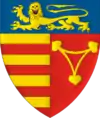Șeica Mare
Șeica Mare (German: Marktschelken; Transylvanian Saxon: Martscheelken;[2] Hungarian: Nagyselyk) is a commune located in Sibiu County, Transylvania, Romania. It is composed of six villages: Boarta (Michelsdorf; Mihályfalva), Buia (Bell; Bólya), Mighindoala (Engenthal; Ingodály), Petiș (Petersdorf; Kispéterfalva), Șeica Mare, and Ștenea (Stein; Isztina). Calvaser (Kaltwasser; Hidegvíz) was also a village until the late 20th century, when it was absorbed by Șeica Mare village.
Șeica Mare | |
|---|---|
 | |
 Location in Sibiu County | |
 Șeica Mare Location in Romania | |
| Coordinates: 46°1′N 24°9′E | |
| Country | Romania |
| County | Sibiu |
| Government | |
| • Mayor (2020–2024) | Nicolae Șușa (PNL) |
| Area | 120.24 km2 (46.42 sq mi) |
| Elevation | 337 m (1,106 ft) |
| Population (2011-10-31)[1] | 4,470 |
| • Density | 37/km2 (96/sq mi) |
| Time zone | EET/EEST (UTC+2/+3) |
| Postal code | 557245 |
| Area code | (+40) 02 69 |
| Vehicle reg. | SB |
| Website | seicamare |
Geography
The commune is situated on the Transylvanian Plateau, on the banks of the river Vișa; the rivers Calva and Râpa flow into the Vișa in Șeica Mare.
Located in the north-central part of the county, the commune is crossed by national road DN14. The closest city is Mediaș, 23 km (14 mi) to the northeast; the county seat, Sibiu, is 32 km (20 mi) to the south.
The Șeica Mare train station serves the CFR rail line 208, which runs north from Sibiu to Copșa Mică.
Demographics
At the 2011 census, Șeica Mare had 4,470 inhabitants. Of those, 88.8% were Romanians, 6% were Hungarians, 4.2% were Roma, and 1% were Germans (more specifically Transylvanian Saxons).
Natives
- Farkas Bolyai (1775–1856), mathematician
- Cornel Oțelea (born 1940), handball player
Villages
Buia village was first attested in a document of 1269, under the name of poss Bulla. In 1918, it had 1167 residents, of whom 736 were Romanians and the rest Germans and Hungarians. By 2002, the population was down to 634: 516 Romanians, 104 Hungarians, and three Roma. The village is in the southern part of the commune, linked to Șeica Mare by an 11 km (6.8 mi) stretch of county road.[3] Farkas Bolyai was born there in 1775.[4]
Mighindoala (German: Engenthal, meaning "Angels' Valley",[5] Hungarian: Ingodály) is a small village in the Șeica Mare commune.
As recently as 1975, the village had in excess of 50 houses, but was gradually deserted after the communist regime withdrew infrastructure such as teachers and doctors.[6] As of 2004, there were only four people left in this village. There were only about ten buildings standing, including the Protestant church. The Romanian Orthodox church no longer has a roof, and is now abandoned.
The only economic activity is agriculture, very much based on the traditional farming of sheep, cows, and horses.
Gallery
.jpg.webp) Ruins of Buia Castle
Ruins of Buia Castle.jpg.webp) The road on Mighindoala river valley
The road on Mighindoala river valley.jpg.webp) German Church in Mighindoala
German Church in Mighindoalaredusa.jpg.webp) House in the village
House in the village The fortified church of Șeica Mare
The fortified church of Șeica Mare The fortified church of Șeica Mare
The fortified church of Șeica Mare.JPG.webp) The fortified church of Șeica Mare
The fortified church of Șeica Mare The fortified church of Șeica Mare
The fortified church of Șeica Mare![Route DN14 [ro] exiting Șeica Mare](../I/SeicaMareSB_(5).JPG.webp) Route DN14 exiting Șeica Mare
Route DN14 exiting Șeica Mare
References
- "Populaţia stabilă pe judeţe, municipii, oraşe şi localităti componenete la RPL_2011" (XLS). National Institute of Statistics.
- Verband der Siebenbürger Sachsen in Deutschland e.V. (i.e. Association of Transylvanian Saxons in Germany). "Marktschelken". Siebenbuerger.de (in German). Retrieved 11 February 2023.
- (in Romanian) Sate aparţinătoare at the Șeica Mare Town Hall site; accessed July 14, 2013
- Barna Szénássy, János Bolyai Appendix, p.220. Elsevier, 1987, ISBN 0-080-87249-2
- "Istru Foundation". Archived from the original on 2011-07-21. Retrieved 2011-05-30.
- Popescu, Adam (November 28, 2010). "Mighindoala, localitatea cu 1,5 locuitori". Evenimentul Zilei (in Romanian). Retrieved November 7, 2022.
